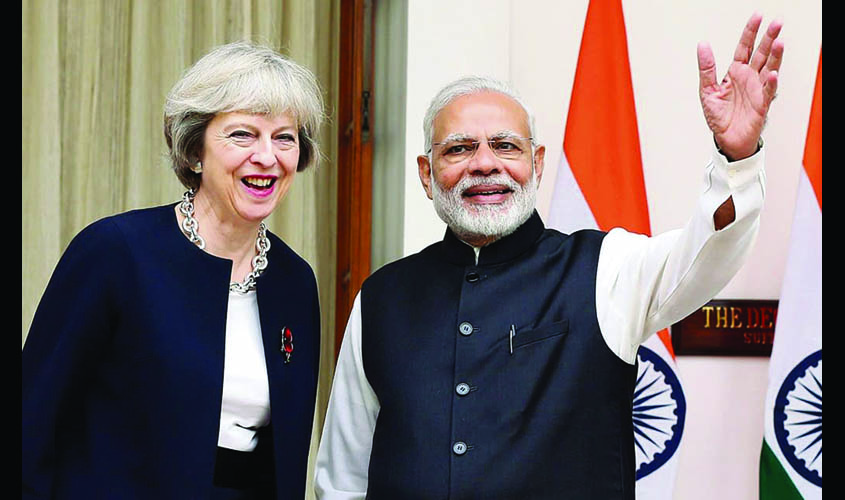Immigration has cast a shadow over trade discussions, especially with the transition from Cameron to May.
It wasn’t supposed to be like this. As Brexiteers celebrated a wholly unexpected result the morning after the Brexit vote, the country was supposed to free itself the shackles of the European Union and go forth and trade with the rest of the world like never before. Among the prominent campaigners was the UK government’s Indian Diaspora champion, Priti Patel MP.
On the second anniversary of the Brexit vote last month, 100,000 people marched in central London to demand a final vote on any UK exit deal. The ordinary person on the street knows less today
A more externally-focused Britain presents an opportunity for India to increase its influence and deepen the bilateral economic relationship.
In Prime Minister David Cameron’s first visit to India, he took a record trade delegation of around a hundred business leaders and made improved relations with India a footing. This has paid significant electoral dividends: in 2005, 76% of the Indian Diaspora in Britain voted for the centre-left Labour party, but by 2015, this fell to just 41%. Instead, Cameron increased the vote-share for the Conservative party from 16% to 49%.
Everywhere you see, the importance of India is evident: Britain’s largest private sector employer is an Indian company (Tata); Britain’s Cabinet and highest offices are full of Indians; the UK has been the fourth largest investor in India over the last 16 years or so; in recent years, India has emerged as the third largest investor into the UK, ahead of Japan, France and Germany; London has emerged as a global hub for infrastructure and green bond issuance for Indian PSUs and private sector companies; and Indians are increasingly dominating the mainstream arts landscape, as the winners of the third annual Eastern Eye Arts, Culture & Theatre Awards on 22 June showed.
But bilateral trade has been flat since 2011—while Indian exports to the UK have consistently increased, UK exports to India have fallen steadily. The depreciation in sterling (against the rupee it fell 17% in morning trading the day after Brexit) has meant UK exports are becoming more competitive, with trade in the last few quarters picking up. In 2017, the UK was the 17th largest trading partner for India. India was the 18th largest trading partner for the UK.
In the Commonwealth Heads of Government meeting earlier this year in London, Prime Minister Narendra Modi was given a special welcome, which underlined the importance of India to Britain, both in a bilateral sense as well as through the Commonwealth channel.
Despite what one hears through the public affairs machinery in some parts of Westminster and Pall Mall, increases in bilateral trade opportunities will not come via the Commonwealth. The top eight Commonwealth countries (including India) make up 8% of the UK’s exports. All Commonwealth countries make up 9%. British exports to Germany are, roughly, more than the whole Commonwealth combined.
The India-UK bilateral trade ministers’ Jetco meeting in London this year explored various avenues of greater economic cooperation. The sense was that Brexit had focused minds to make Jetco into more of a deliverables-focused meeting.
But immigration has cast a shadow over bilateral trade discussions. The transition from David Cameron to Theresa May as Prime Minister has introduced a very clear hawkish tone towards immigration. Indeed, immigration formed a large part of the first bilateral discussion between PMs Modi and May when they met in Delhi two years ago.
It’s no secret that Indian student numbers to Britain have fallen from a high of 40,000 to 16,000 (before recovering marginally) due to stricter UK immigration rules. May has long held the view that many of these came to the UK to study at “bogus” colleges, and then stayed on illegally. The government had initially quoted a figure of 100,000 such undocumented immigrants, which has been consistently debunked. The true figure is likely to be closer to 5,000. May has used this cover to deport thousands of Indians in various scandals that have come to light particularly since CHOGM. A study by the Times suggests that up to 7,000 students could have been wrongly deported after they were accused of falsifying their English language test. Whatever the right figure is, the message from the government is clear: if India wants more doctors, IT workers and students to be allowed into Britain more easily, it must do more to take back the over-stayers. And this is the fundamental problem with Britain’s muddled approach on Brexit. The British government says it wants for the country to go forth and trade more with non-EU partners. Parts of the government genuinely want to be outward looking, but then there is the Home Office, whose sole purpose seems to be to ensure a restrictive visa regime to keep Brexiteers happy.
There are some aspects of the bilateral relationship, Brexit or a hawkish May government will not impact: investment from and to India will remain strong and India will continue to be well represented in Westminster, for example. The recent launch of an investment fund focused specially on investing in British companies seeking to enter India is a case in point.
How the relationship grows depends also on the seat of power in Delhi. With elections in 2019, Indian government outreach activities towards the Indian Diaspora have been ramping up. His “Bharat Ki Baat Sabke Saath” interaction with the Diaspora in London in April was a much talked-about event amongst the Gujarati Diaspora. Given the largest portion of the 1.5m Diaspora is Gujarati, the buzz in Harrow, Southall and Leicester is certainly to welcome a new term for PM Modi. Outside these communities, Modi is still seen as the tallest leader in India, but there is a growing appetite for change. This marks a remarkable shift from just a year ago.
Pratik Dattani is Managing Director of cross-border consultancy Economic Policy Group, and a former UK Director of FICCI.

